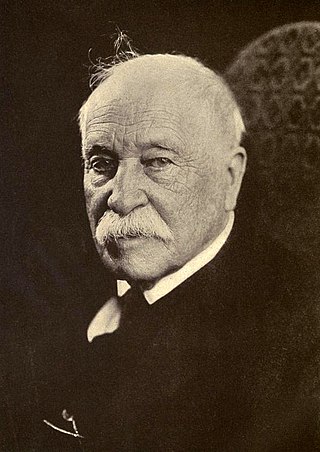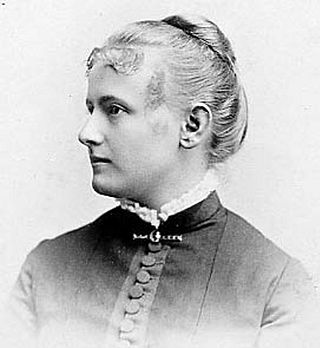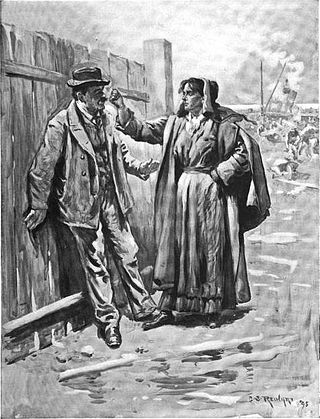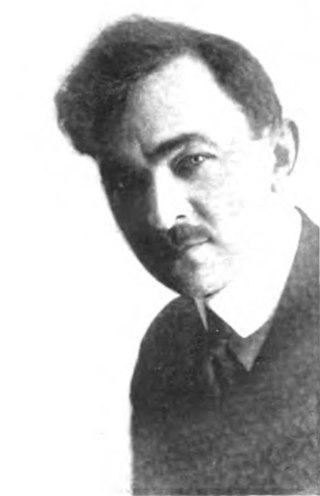
Kate Douglas Wiggin was an American educator, author and composer. She wrote children's stories, most notably the classic children's novel Rebecca of Sunnybrook Farm, and composed collections of children's songs. She started the first free kindergarten in San Francisco in 1878. With her sister during the 1880s, she also established a training school for kindergarten teachers. Kate Wiggin devoted her adult life to the welfare of children in an era when children were commonly thought of as cheap labor.

Robert William Chambers was an American artist and fiction writer, best known for his book of short stories titled The King in Yellow, published in 1895.

William Dean Howells was an American realist novelist, literary critic, and playwright, nicknamed "The Dean of American Letters". He was particularly known for his tenure as editor of The Atlantic Monthly, as well as for the novels The Rise of Silas Lapham and A Traveler from Altruria, and the Christmas story "Christmas Every Day," which was adapted into a 1996 film of the same name.

Carson McCullers was an American novelist, short-story writer, playwright, essayist, and poet. Her first novel, The Heart Is a Lonely Hunter (1940), explores the spiritual isolation of misfits and outcasts in a small town of the Southern United States. Her other novels have similar themes and most are set in the Deep South.

Francis Hopkinson Smith was an American author, artist and engineer. He built the foundation for the Statue of Liberty, wrote many stories and received awards for his paintings.

William John Locke was a British novelist, dramatist and playwright, best known for his short stories.

Mary Johnston was an American novelist and women's rights advocate from Virginia. She was one of America's best selling authors during her writing career and had three silent films adapted from her novels. Johnston was also an active member of the Equal Suffrage League of Virginia, using her writing skills and notability to draw attention to the cause of women's suffrage in Virginia.

Julia Vida Dutton Scudder (1861–1954) was an American educator, writer, and welfare activist in the social gospel movement.

Mary Tappan Wright (1851–1916) was an American novelist and short story writer best known for her acute characterizations and depictions of academic life. She was the wife of classical scholar John Henry Wright and the mother of legal scholar and utopian novelist Austin Tappan Wright and geographer John Kirtland Wright.
Sylvia Jean Wilkinson is an American author.
Garland Roark was an American writer known best for his nautical/adventure fiction. His first novel Wake of the Red Witch, published 1946, was a Literary Guild selection and adapted later by Republic Pictures company as a movie featuring John Wayne.

Charles Morton Stewart McLellan (1865–1916) was a London-based American playwright and composer who often wrote under the pseudonym Hugh Morton. McLellan is probably best remembered for the musical The Belle of New York and drama Leah Kleschna.

Tom Grogan is a novel published in 1896 by Francis Hopkinson Smith. It was the bestselling book in the United States in 1896 according to Publishers Weekly. The novel was adapted into a play in 1896. An art print of the book cover is held in the Library of Congress.

The Seats of the Mighty is a novel published in 1896 by Gilbert Parker. It was first published in serial form in The Atlantic starting in March 1895, and released in book form in 1896. It was the third highest best-selling book in the United States in 1896.
This is a list of bestselling novels in the United States from 1895 through 1899, as determined by The Bookman, a New York–based literary journal. Without the international copyright law which came into force in 1891, these volumes could have been printed and published by anyone, the change in this state of affairs made it possible to compile accurate sales figures.

Peter: A Novel Of Which He Is Not The Hero is a novel published in 1908 by Francis Hopkinson Smith, which was the sixth best selling book in the United States in 1908, and ninth best-selling book of 1909. It sold in excess of 100,000 copies.

Deep Waters is a lost 1920 American silent drama film directed by Maurice Tourneur and written by F. Hopkinson Smith, Michael Morton and John Gilbert. The film stars Rudolph Christians, Barbara Bedford, John Gilbert, Florence Deshon, Jack McDonald, Henry Woodward, and George Nichols. The film was released on October 10, 1920, by Paramount Pictures.

Ellen Warner Olney Kirk was an American novelist. Her novels tended to have romance plots set in New York or Philadelphia.

Katharine Newlin Burt was an American novelist and film scenarist. She was a prolific author of Westerns and other novels, with a publishing career that spanned more than 60 years. At least seven of Burt's published works were adapted to film, and she authored the original screen stories for two more films.

Harry James Smith was an American playwright and novelist. His best known plays include A Tailor-Made Man, first produced in 1917 and adapted into films of the same name in 1922 and 1931. His 1913 play Blackbirds was also adapted into films. Educated at Williams College and Harvard University, he also studied biology, taught briefly at Oberlin University and was an editor at The Atlantic Monthly before turning to writing full-time. He was killed in a traffic collision in British Columbia while collecting peat moss for its use in surgical dressings.

















